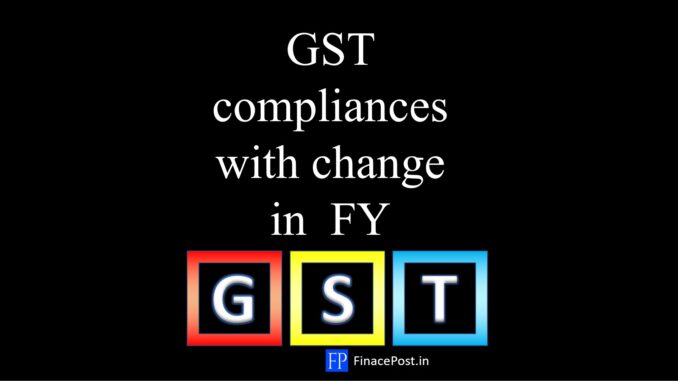
Last updated on March 29th, 2023 at 04:31 pm
GST checklist with the onset of FY 2023-24
Based on provisions and rules under the GST regime, there are certain to-dos that need every taxpayer’s attention before the beginning of the new financial year.
Renewal of LUT
Letter of Undertaking is a pre-requisite for exports without the payment of IGST.
The validity period of a LUT is only for a financial year. Hence a fresh application in Form GST RFD-11 needs to be made every year. (Read in detail about LUT)
New Unique series for Invoices
Rule 46 and Rule 49 of GST – Taxpayers are required to start a new unique series for generating invoices/bills of supply for every financial year.
Note: Serial number of invoices should be consecutive and it should not exceed 16 characters. A serial number can contain alphabets, numerals, special characters, etc but it is advisable to keep it unique consecutive, and simple so it is easy to reconcile from JSON files too.
Applicability of e-invoicing
With effect from 1st October 2022, provisions of e-invoicing will be applicable to taxpayers whose aggregate turnover exceeds Rs 10 crores in any preceding financial year after the rollout of GST.
Taxpayers need to verify whether the provisions of e-invoicing are applicable to them from the e-invoicing portal (verify here). If applicable then the registration and onboarding process for the generation of e-invoicing needs to be done before the start of the financial year. (Read in detail about E-Invoicing under GST)
Applicability of HSN/SAC
If AATO is up to Rs 5 crores then it will be mandatory to quote 4-digit HSN for B2B invoices (optional for B2C invoices).
If AATO is above Rs 5 crores then it will be mandatory to quote 6-digit HSN for B2B as well as B2C invoices. (Read in detail about HSN/SAC codes)
Opt-in of the Composition Scheme
Verify whether you are eligible to opt-in for the composition scheme based on your AATO of the preceding year. Then you can switch from being a regular taxpayer to a composition taxpayer by filing an application to opt for Composition Levy in Form GST-CMP-02 at GST Portal
Reconciliation of GST returns with Books
- Reconciliation of turnover/sales with GSTR 1 and GSTR 3B and books of accounts and e-waybill data and e-invoice reporting Portal.
- Reconciliation of inward supplies/purchases with GSTR 2A/GSTR 2B with books of accounts.
- Reconciliation of outward liabilities based on the above reconciliations and GST liability settled through electronic credit ledger and paid through electronic cash ledger. In case there is any shortfall the same shall be paid along with interest.
Tax Invoice/DN/CN/Self Invoice for RCM (if any)
- If any invoice/debit note/credit note was not recorded the same should be recorded.
- If any invoice/debit note/credit note was incorrectly recorded the same should be amended. Make amendments if any transaction was incorrectly recorded as B2C supplies instead of B2B supplies and vice-versa.
Input Tax Credit
Availment
- Verify and avail ITC if an eligible ITC was not recorded due to human/system error.
- Verify and avail the ITC on charges levied by the bank if not availed during the year.
- Verify whether ITC relating to all your inward supplies and inward services reflects in GSTR 2A/2B, if not confirm the correct filing status with the supplier.
- Verify whether ITC is availed for all the imports as ITC for imports does not correctly reflect in GSTR 2A/GSTR2B
Reversal
- Reverse the ITC if you are not in possession of a valid tax invoice or debit note issued by a registered supplier – Sec 16(2)(a)
- Reverse the ITC if ITC was availed despite non-reflection in Form GSTR 2B – Sec 16(2)(aa)
- Reverse the ITC if goods or services or both are not actually received – Sec 16(2)(b)
- Reverse the ITCif ITC was availed despite the reflection of restricted status in Form GSTR 2B – Sec 16(2)(ba)
- Reverse the ITC if the tax has not been actually paid to the Government – Sec 16(2)(c)
- Reverse the ITC if GSTR 3B is not filed by the supplier – Sec 16(2)(d)
- Reverse the ITC along with interest if you(recipient) have failed to pay the supplier within 180 days from the date of issuing an invoice – Second Proviso to Sec 16(2)(d)
- Reverse the ineligible ITC if availed – Rule 42 43
- Reverse the blocked ITC if availed – Section 17(5)
Others
- Verify whether the impact of GST for inter-company transactions/ inter-organization transactions has been correctly given.
- Verify whether ITC available is correctly distributed by the Input Service Distributor.
- Verify whether no ITC is availed from the suppliers whose registration has been canceled(post the date of cancelation).
Reverse Charge Mechanism
Verify whether wherever tax is required to be paid on a reverse charge basis is paid or not.
Verify whether the ITC claimed for tax paid on a reverse charge basis relates to the same financial year as there have been instances where the Government has disallowed earlier period’s ITC as it was time-barred.
Interest
Verify whether the interest which was not getting auto-calculated is paid or not. If not it is advisable to pay now and not delay it any further.
- 50th GST Council Meeting - 11/07/2023
- GST Compliance Calendar of October 2023 - 01/04/2023
- GST sections amended in Finance Act 2023 - 27/03/2023
Disclaimer: The above content is for general info purpose only and does not constitute professional advice. The author/ website will not be liable for any inaccurate / incomplete information and any reliance you place on the content is strictly at your risk.
Follow us on Social Media by clicking below
Follow @financepost_in
Full fledged Article,throughly studying by me.👌🙏💐👍👌👌👌👌
Thank you. Glad it was helpful.